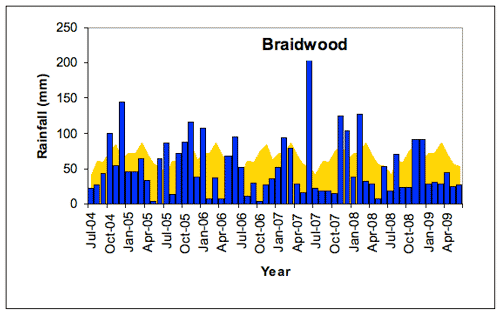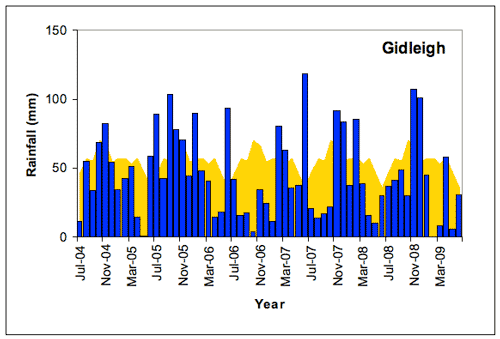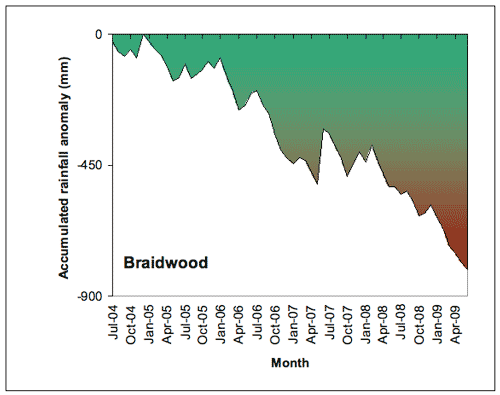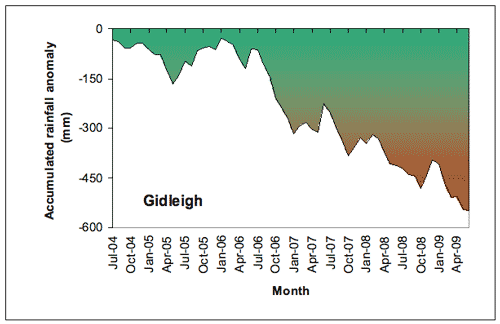Palerang
Please note: Text or data highlighted in this colour represent an update to this indicator for the period 2008/09. All rainfall figures have been updated on this page.
Rainfall Analysis
The main rainfall observing sites used in this analysis were Braidwood (Bureau of Meteorology Station No. 069010) – record commences in 1887; and Gidleigh (No. 070035) – record commences 1886, located 7 km from the centre of Bungendore. Data from nearby stations were used to calculate values for months with missing data at this site (see Appendix 2 for further information).
Note that in the following analyses rainfall totals for individual months or years (where the year is defined as the 12 months from July to June) are compared to the long-term average (or climatology) from 1961-1990. A 30-year period is used to calculate climatological averages to conform with World Meteorological Organisation practice; this takes into account year-to-year variations and less frequent events such as El Niño or La Niña. This particular 30-year period is used internationally as a standard climatological average period.
As shown in the table below, Braidwood was drier than average in all five years in the period 2004/05-2008/09 whilst Gidleigh was drier than average in four of these years. The driest year at Braidwood was 2008/09, when rainfall was 36.4% below the long-term average whilst the driest year at Gidleigh was 2007/8 when rainfall was 28.2% below average. The wettest year in the last four years was 2005/06 for both places with Braidwood being 7.3% below average and Gidleigh being 12.8% above average.
| Rainfall Statistics | Braidwood | Bungendore (Gidleigh) | ||||||||
|---|---|---|---|---|---|---|---|---|---|---|
2004/5 |
2005/6 |
2006/7 |
2007/8 |
2008/9 |
2004/5 |
2005/6 |
2006/7 |
2007/8 |
2008/9 |
|
| Annual Total* (mm) | 645.2 |
729.6 |
663.6 |
582.1 |
500.2 |
508.5 |
732.5 |
482.7 |
465.8 |
512.8 |
| Anomaly (mm) | -141.5 |
-57.1 |
-123.1 |
-204.6 |
-286.5 |
-140.6 |
83.4 |
-166.5 |
-183.3 |
-136.3 |
| Anomaly (%) | -18.0 |
-7.3 |
-15.7 |
-26.0 |
-36.4 |
-21.7 |
12.8 |
-25.6 |
-28.2 |
-21 |
| Mean (1961-1990) (mm) | 786.7 |
649.1 |
||||||||
*Note: annual totals were calculated for the 12 months July-June.
Monthly Rainfall, 2004-2009
A comparison of monthly rainfall totals with the long-term monthly average rainfall at Braidwood and at Gidleigh (Figure 1a and b) shows that the region experienced generally below average rainfall over this four year period, especially in the latter half of the period. While rainfall trends at both locations are similar, Braidwood tended to be not as wet as Gidleigh in 2005/6. A prolonged dry period commenced in March 2006 and extended to October 2007. During this period there were only 5 months over near average or above average rainfall in the region. The prolonged period of below-average rainfall in 2006-2007 was associated with an El Niño event while the wetter conditions from November 2007 to February 2008 and November/December 2008 were due to the development of La Niña events. Another prolonged dry period extends from March 2008 to June 2009. Over this period there have only been 3 months of above average at Braidwood and 4 months at Bungendore.
a b
|
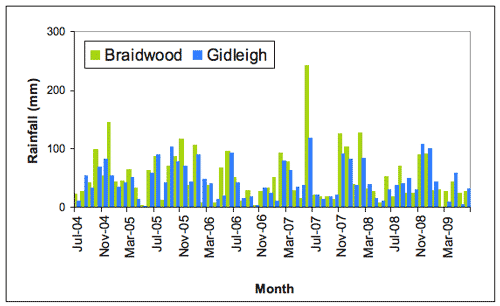 |
Of the 60 months in this period, 40 (67% of the record) had below-average rainfall at Braidwood, and 41 (68%) at Gidleigh (Figure 3). The most prolonged dry spell in the region began in February 2006 and continued through to October 2007 during which there were only 5 months of average or above average rainfall which was then followed by a dry autumn. Autumn 2005 was also extremely dry across the region. Another prolonged dry period has persisted from March 2008 to June 2009. The driest individual month at Braidwood was May 2005 where only 3 mm was recorded (long-term average is 55 mm) while no rain was recorded at Gidleigh in February 2009 (long-term average is 56.3 mm). October 2006 was also extremely dry with 3.2 mm recorded at Braidwood and 4 mm at Gidleigh. The only periods of near average or above average rainfall were October to December 2004, September 2005 to January 2006, February/March 2007, June 2007 and November 2007 to February 2008. The wettest individual month at both locations was June 2007 when Braidwood recorded 242.4 mm (long term average 52.4 mm) while Gidleigh recorded around 118.6 mm (long term average 35.2 mm). Given that June 2007 was an extreme event and the monthly figure for Gidleigh was a derived value, this figure could well be higher. The rainfall at Braidwood places June 2007 as the 4th wettest June on record since 1888.
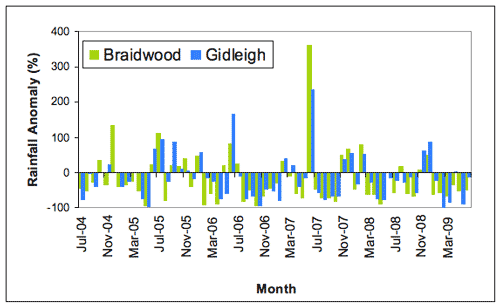 |
The results of the generally dry conditions across the region are evident from Figure 4. While there was a slight variation in rainfall deficits in 2004/5 between the 2 locations, they then both showed a rapid increase in the rainfall deficit during 2006/7 which then eased late 2007/8 before increasing again during 2008/9. The final accumulated deficits over the period were 811,2 mm at Braidwood (103% of average Jul-Jun annual rainfall) and 551.6 mm at Gidleigh (85% of average Jul-Jun annual rainfall).
These figures indicate that similar conditions were experienced across the whole region.
a
b
|
The climatological context for rainfall at Braidwood and Gidleigh
The long-term perspective
As is typical of the region, Braidwood and Gidleigh have experienced large fluctuations in annual (July-June) rainfall, including several extended periods of above- and below-average rainfall since records began in the late 1800s. In general, annual rainfall was lower and less variable early in the 20th century, followed by a period of greater variability. Rainfall variability has been lower since about 1980 (Figures 5 and 6). Figures 5 and 6 both reflect that this recent dry period is similar to the dry periods experienced in the periods of the late 19th to early 20th Centuries and the late 1900’s to the end of World War II and therefore to this point in time can be considered as just part of the natural variation.
- Rainfall in the late 19th and early 20th century was generally below average (to about 1950), although 1924 was a particularly wet year at Braidwood. Since the mid-20th century, annual rainfall totals have been more variable.
- Several wetter-than-normal years around 1950 and 1960 produced a generally wetter period then; the same is true of the mid 1970s.
- A generally drier period around 1980 was followed by slightly above-average rainfall until the early 1990s. Since 1992 conditions have been generally drier than average, particularly since 2000.
The wettest year (July-June) on record at Braidwood was 1924/5 (1330 mm); the driest year was 1956/7 (380 mm).
- At Gidleigh the wetter-than-normal years in the 1950s showed stronger anomalies than those at Braidwood, although the early 1960s wet spell was of similar magnitude at both stations.
- The general patterns of interannual rainfall variation have been similar at the two stations, although there are differences that are probably due to the higher probability of coastal influences on the climate of Braidwood than on that of Gidleigh.
The wettest year (July-June) on record at Gidleigh was 1949/50 (1167 mm); the driest year was 1896/7 (333 mm).
![Figure 5. Annual (July-June) rainfall at Braidwood from 1885/6 to 2008/9 depicted as deviations from the long-term mean. A 5-year running mean is superimposed to highlight wetter and drier periods. [Deviations were calculated as the difference between the rainfall for each year and the mean for the period 1961-1990 (scale in mm).]](../images/palerang/rain06.gif) |
![Figure 6. Annual (July-June) rainfall at Gidleigh from 1885/6 to 2008/9 depicted as deviations from the long-term mean. A 5-year running mean is superimposed to highlight wetter and drier periods. [Deviations were calculated as the difference between the rainfall for each year and the mean for the period 1961-1990 (scale in mm).]](../images/palerang/rain07.gif) |
The drier than average conditions across the region, particularly since 2002, have resulted in a substantial accumulated rainfall deficit (relative to the amount of rainfall that would have been recorded if average monthly rainfall had been received through this period). While rainfall deficits did not increase as rapidly at Gidleigh as at Braidwood in 2002/03 (Figure 7b) the increasing deficit followed similar trends at the two sites in 2006/07 (Figure 7a). The impact of two successive El Nino events (2002/3 and 2006/7) without a compensating wet period is clear. Overall during this 9 year period Braidwood experienced 78 months (72%) of rainfall deficit while Gidleigh experienced 76 months (71%). Overall the total rainfall deficit over this period was 1767.4 mm at Braidwood (239% of annual Jul-Jun average) and 1048.9 mm at Gidleigh (160% of annual Jul-Jun average). Given the relatively close figures between the two locations for the 2004/9 period, it can be therefore considered that the Braidwood area was more severely impacted by the 2002/3 El Niño than in the Gidleigh region.
a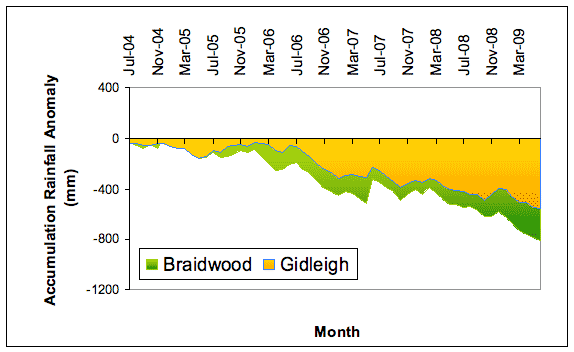 b b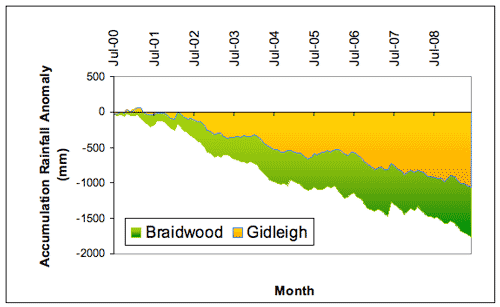 |
About the data
